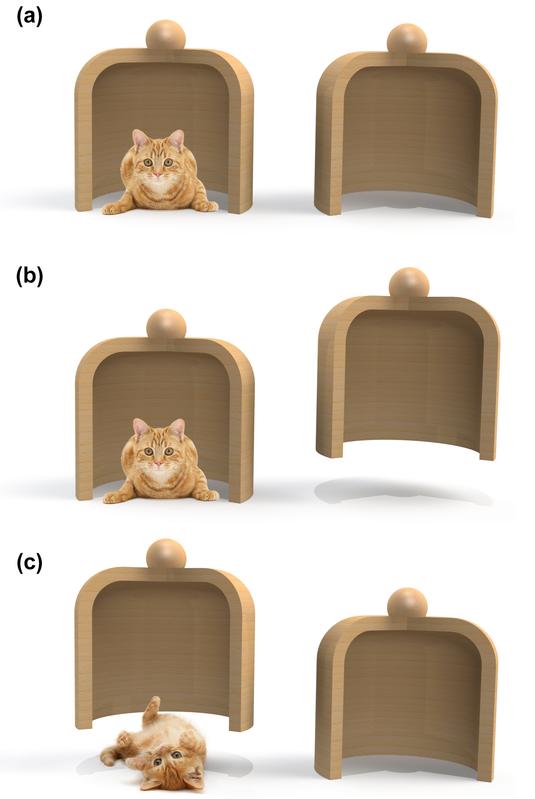Atoms can be in two places at the same time

The Bonn team has developed a measurement scheme that indirectly measures the position of an atom. In essence, one looks where the Caesium atom is not. The image clarifies this procedure. Let us assume that two containers are in front of us and a cat is hidden under one of them (a). However, we do not know under which one. We tentatively lift the right jar (b) and we find it empty. We, thus, conclude that the cat must be in the left jar and yet we have not disturbed it. Had we have lifted the left jar instead, we would have disturbed the cat (c), and the measurement must be discarded. In the macro-realist’s world, this measurement scheme would have absolutely no influence on the cat’s state, which remains undisturbed all the time. In the quantum world, however, a negative measurement that reveals the cat’s position, like in (b), is already sufficient to destroy the quantum superposition and to influence the result of the experiment. The Bonn physicists have exactly observed this effect. © Andrea Alberti / www.warrenphotographic.co.uk
Physicists of the University of Bonn have constructed an experiment designed to possibly falsify this thesis. Their first experiment shows that Caesium atoms can indeed take two paths at the same time.
Almost 100 years ago physicists Werner Heisenberg, Max Born und Erwin Schrödinger created a new field of physics: quantum mechanics. Objects of the quantum world – according to quantum theory – no longer move along a single well-defined path. Rather, they can simultaneously take different paths and end up at different places at once. Physicists speak of quantum superposition of different paths.
At the level of atoms, it looks as if objects indeed obey quantum mechanical laws. Over the years, many experiments have confirmed quantum mechanical predictions. In our macroscopic daily experience, however, we witness a football flying along exactly one path; it never strikes the goal and misses at the same time. Why is that so?
“There are two different interpretations,” says Dr. Andrea Alberti of the Institute of Applied Physics of the University of Bonn. “Quantum mechanics allows superposition states of large, macroscopic objects. But these states are very fragile, even following the football with our eyes is enough to destroy the superposition and makes it follow a definite trajectory.”
Do “large” objects play by different rules?
But it could also be that footballs obey completely different rules than those applying for single atoms. “Let us talk about the macro-realistic view of the world,” Alberti explains. “According to this interpretation, the ball always moves on a specific trajectory, independent of our observation, and in contrast to the atom.”
But which of the two interpretations is correct? Do “large” objects move differently from small ones? In collaboration with Dr. Clive Emary of the University of Hull in the U.K., the Bonn team has come up with an experimental scheme that may help to answer this question. “The challenge was to develop a measurement scheme of the atoms’ positions which allows one to falsify macro-realistic theories,” adds Alberti.
The physicists describe their research in the journal “Physical Review X:” With two optical tweezers they grabbed a single Caesium atom and pulled it in two opposing directions. In the macro-realist’s world the atom would then be at only one of the two final locations. Quantum-mechanically, the atom would instead occupy a superposition of the two positions.
“We have now used indirect measurements to determine the final position of the atom in the most gentle way possible,” says the PhD student Carsten Robens. Even such an indirect measurement (see figure) significantly modified the result of the experiments. This observation excludes – falsifies, as Karl Popper would say more precisely – the possibility that Caesium atoms follow a macro-realistic theory. Instead, the experimental findings of the Bonn team fit well with an interpretation based on superposition states that get destroyed when the indirect measurement occurs. All that we can do is to accept that the atom has indeed taken different paths at the same time.
“This is not yet a proof that quantum mechanics hold for large objects,” cautions Alberti. “The next step is to separate the Caesium atom’s two positions by several millimetres. Should we still find the superposition in our experiment, the macro-realistic theory would suffer another setback.”
Publication: Carsten Robens, Wolfgang Alt, Dieter Meschede, Clive Emary und Andrea Alberti: Ideal negative measurements in quantum walks disprove theories based on classical trajectories; Physical Review X, 20.1.2015 (DOI: 10.1103/PhysRevX.5.011003)
Contact:
Andrea Alberti
Institut für Angewandte Physik (IAP), Universität Bonn
Tel: 0228/73-3483 oder -3471
E-Mail: alberti@iap.uni-bonn.de
WWW: http://quantum-technologies.iap.uni-bonn.de
Media Contact
All latest news from the category: Physics and Astronomy
This area deals with the fundamental laws and building blocks of nature and how they interact, the properties and the behavior of matter, and research into space and time and their structures.
innovations-report provides in-depth reports and articles on subjects such as astrophysics, laser technologies, nuclear, quantum, particle and solid-state physics, nanotechnologies, planetary research and findings (Mars, Venus) and developments related to the Hubble Telescope.
Newest articles

A ‘language’ for ML models to predict nanopore properties
A large number of 2D materials like graphene can have nanopores – small holes formed by missing atoms through which foreign substances can pass. The properties of these nanopores dictate many…

Clinically validated, wearable ultrasound patch
… for continuous blood pressure monitoring. A team of researchers at the University of California San Diego has developed a new and improved wearable ultrasound patch for continuous and noninvasive…

A new puzzle piece for string theory research
Dr. Ksenia Fedosova from the Cluster of Excellence Mathematics Münster, along with an international research team, has proven a conjecture in string theory that physicists had proposed regarding certain equations….



